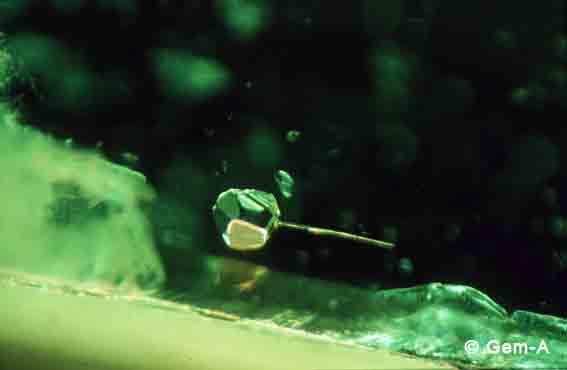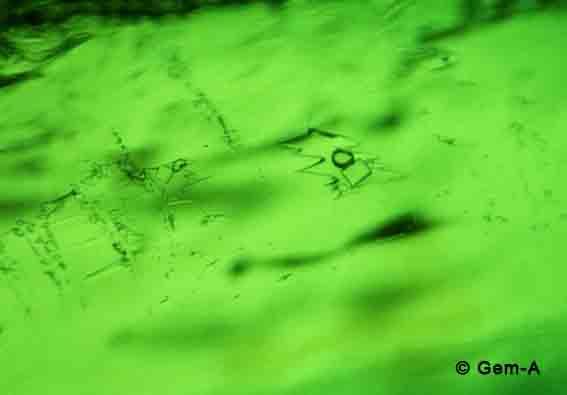
Those born in May are lucky enough to count emerald as their birthstone. Here, Gem-A gemmology tutor, Lily Faber FGA DGA EG, explores the history and qualities of this beautiful green beryl.
The emerald is arguably the most well-known and desired member of the beryl family with its brilliantly verdant colour. Green stones have been called emeralds for thousands of years – since around 4,000 BC – regardless of whether they actually were what we know as emeralds today.
Emerald Meaning and Myths
At one time, emeralds were believed to give one the ability to predict the future, especially when held underneath the tongue. They were also believed to confer riches upon the wearer and were used as protection against poison and demonic possession. Used as a symbol of immortality and wealth, emeralds have been valued for centuries for both their appearance and symbolism.

Emerald crystals in calcite. Photographed by Henry Mesa.
Finally, it is said that emeralds are beneficial for the eye and it is reported that some lapidaries keep an emerald on their bench to look at, giving relief to their tired eyes after a long day of cutting gems.
Emerald Gemstone Localities
Emeralds have been mined for thousands of years, stretching back to Egypt near the Red Sea around 2000 BC in what were known as Cleopatra’s emerald mines. While Egyptian emeralds were some of the first to be mined and traded, it was the discoveries of Colombian emeralds by 16th century Spanish conquistadors like Pizarro that brought strikingly saturated green crystals to the European market – particularly to the Spanish court and beyond.

A large Colombian emerald crystal. Photograph by Henry Mesa.
It is still thought that emeralds from the Colombian mines such as Chivor, Muzo and Cozquez are the finest in the world. Other localities that produce emeralds are Brazil, Russia, India, Zambia, Zimbabwe, Madagascar and North Carolina, USA.
Emerald Crystals
Emeralds typically form as hexagonal prisms with a flat pinacoid top and base. Sometimes, they can have rectangular etch pits on the prism faces and hexagonal etch pits on the top of the crystal.

Pyrite Inclusion in Emerald.
Due to their brittle nature, these gemstones often have internal fractures along with many different types of inclusions. Emeralds are routinely oiled or even resin-filled, to reduce the appearance of these internal fractures. It is possible to see a blue or yellow flash within the stone if it has been filled with a resin, but careful observation is needed.
Read more: What Can Emerald Inclusions Tell Us About Their Origin?
Also found in Colombia are trapiche emeralds, in which an emerald forms with a central, hexagonal crystal from which radiate six emerald segments that are separated by a fine-grained mixture of colourless beryl and nearly black albite.
Emerald Gemstones Inclusions
Inclusions are numerous and varied, and sometimes one can tell where the emerald was mined based on what lies inside the gemstone. Colombian emeralds, for example, typically have three-phase inclusions, which consist of a liquid, a solid mineral inclusion and a gas bubble contained in a jagged cavity.
Read more: What Makes a Gemstone Rare?
Other inclusions typical of their localities are comma-shaped two-phase inclusions found in Indian emeralds, and long, curved tremolite inclusions in emeralds from Zimbabwe. There are many other inclusions such as bamboo-like actinolite, pyrite and colourless rhomb-shaped crystals.

Three Phase Inclusion in Emerald.
Emerald Cut
There is a type of square or rectangular step-cut with truncated corners that is so often used for this gemstone that it is more commonly known as the emerald cut. The corners are removed so as to protect the brittle stone from unwanted chipping and breakage at the stone’s most vulnerable points.
Read more: What is the Link Between an Emerald and the Emerald Cut?
Claw settings are used, particularly at the corners and along the sides, but a more practical setting would be the bezel or rub-over setting in order to form a barrier around the entire stone. Whether you love emeralds or prefer another type of beryl, there is no arguing that its deep green colour and lore make it a gemstone to be admired.
Start your gemmology journey with a Gem-A Workshop, designed to get you up-to-speed with the basics of gemstones. Find out more here.
The Gem-A Gemmology Foundation course is the ideal way to turn your passion for gemstones into something more. Discover all our gemmology courses here.
Cover image: Emerald in quartz by Henry Mesa.


